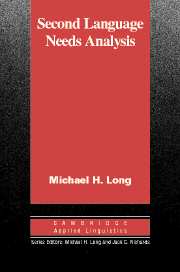Overview: A rationale for needs analysis and needs analysis research
Published online by Cambridge University Press: 25 January 2010
Summary
In an era of shrinking resources, there are growing demands for accountability in public life, including education. In foreign and second language teaching, one of several consequences is the increasing importance attached to careful studies of learner needs as a prerequisite for effective course design.
Successful language learning is vital for refugees, immigrants, international students, those receiving education or vocational training through the medium of a second language in their own country, and individuals in occupations requiring advanced foreign language proficiency, among others. The combination of target language varieties, skills, lexicons, genres, registers, etc., that each of these and other groups needs varies greatly, however, meaning that language teaching using generic programs and materials, not designed with particular groups in mind, will be inefficient, at the very least, and in all probability, grossly inadequate. Just as no medical intervention would be prescribed before a thorough diagnosis of what ails the patient, so no language teaching program should be designed without a thorough needs analysis. Every language course should be considered a course for specific purposes, varying only (and considerably, to be sure) in the precision with which learner needs can be specified – from little or none in the case of programs for most young children to minute detail in the case of occupationally-, academically-, or vocationally-oriented programs for most adults.
Information
- Type
- Chapter
- Information
- Second Language Needs Analysis , pp. 1 - 16Publisher: Cambridge University PressPrint publication year: 2005
Accessibility standard: Unknown
Why this information is here
This section outlines the accessibility features of this content - including support for screen readers, full keyboard navigation and high-contrast display options. This may not be relevant for you.Accessibility Information
- 21
- Cited by
